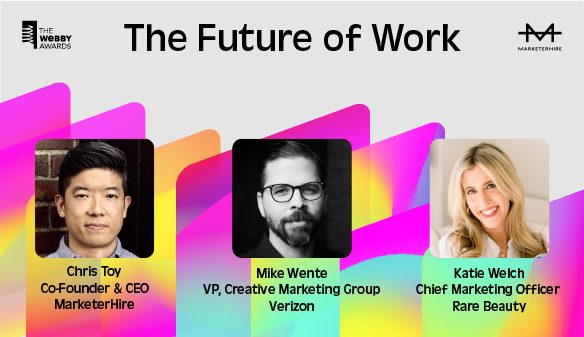The decisions companies are making during a year of change will forever impact their trajectory. Questions of how digital marketers should organize their teams, collaborate, and build new processes are no longer made behind closed doors but instead have become fodder for public discourse. How do you decide if your org chart meets your company’s future needs? How can you give employees more autonomy?
The Webby Awards virtually gathered three marketing leaders to explore how they are shaping their teams during The Future of Work. The virtual panel was hosted in partnership with MarketerHire, a talent platform that matches organizations with expert, pre-vetted freelance marketers. Here are five main takeaways from the conversation led by Webby Awards CEO David-Michel Davies, featuring Katie Welch, Chief Marketing Officer at Rare Beauty, Mike Wente, VP of Verizon’s Creative Marketing Group, and Chris Toy, Co-Founder & CEO of MarketerHire.
1. Consider Growth Marketing and Middle Layer Roles
Your competition will. Industry shifts that began to mold pre-pandemic skyrocketed once companies moved into remote working. Chris Toyand the MarketerHire team have witnessed a growing demand for both “seasonal” and more “topical” roles for marketing teams.
“Recently there’s been a surge of people looking for paid social, specifically around Facebook and specifically around ‘can someone help us navigate iOS14 changes,‘” said Toy. Recently email marketers have been chasing down paid social media marketers as new roles that are becoming integral within a marketing team. Another seasonal uptick is a growing demand for parental leave cover, particularly within Fortune 500 companies and startups.
However generally, companies’ most sought-after roles are Growth Marketers or CMOs to function in the middle layer of a team and run daily operations, said Toy.
2. Organize Your Team into Majors and Minor
Mike Wente stacks his creative team by prioritizing majors and minors. “There’s a primary focus area that you have a specialist in that can get really deep, some people call it the T-shape as well,” said Wente. This method lets specialized marketers focus on their “bedrock” within Verizon’s structure, while having the capability to apply their knowledge more broadly.
Another key to hiring for employees that fill major and minor roles your team needs is honing in on their specific attributes. Wente focuses on looking for creative problem solvers. “That can apply to a project manager, to a strategist, to an art director. How they can look at a problem or some sort of challenge in front of them and creatively look at a different way to be able to solve it. That’s kind of the biggest thing that we look for in our staff.” he said.
3. Set Up Clear Expectations
Collaboration has looked very different this year, and companies are navigating how to do this remotely, in-person should they choose to go back into the office, or using some combination of the two. For effective collaboration in any physical setting, Rare Beauty’s Katie Welch believes it’s essential to make sure a team is “hyper focused and have everyone so clear on the direction that you’re going, so that the generalists and specialists know their path forward.” That is the strategy that helped Rare Beauty’s team launch their brand at Sephora during September 2020.
Prior to the pandemic, there were many communication crutches to meet people or have a workflow that teams relied on to collaborate, said Toy. When shelter-in-place orders went into effect, suddenly those crutches were gone—and that’s not necessarily a bad thing. If leaders provide clarity of expectations and directions, employees can go forth in their responsibilities.
4. Prioritize Culture, Wherever You Work
Onboarding is among the many cornerstones of the workplace that are shifting. Companies will need to navigate how to do this whether in-person or virtually. For Mike Wente, he started a new position leading Verizon’s 200+ person, in-house creative during the height of the pandemic. That reality meant working to be more accessible to foster quick bonds and create a supportive work culture. “That’s the benefit of working in this environment, we’re able to do a lot of meetings. Almost to a detriment.”
Prioritizing culture in distributed environments also means tending to your communication style with care, especially when reacting to work. For Wente, it’s important to be “hyper aware that when you’re having a meeting to give feedback, whoever you’re talking to doesn’t have the benefit of seeing you walking down the hallway.” As you might not see team members for another week, communication should be treated with care.
5. Give Autonomy, With Parameters
Companies around the world are trying unique ways to give employees autonomy. Distinguish where you work and when you work. The challenge to find a successful method is unique to every company, and requires an assessment of both work environments and employees themselves. “Being able to have this autonomy and work getting handed to you, there’s the responsibility of can you deliver?” said Wente.
For Toy, the onus also lies on both companies and talent themselves to succeed in autonomous work. At MarketerHire, they vet incoming talent with two questions: “We vet for technical skills: ‘Do you know how to do this job?’ and we vet for ‘Do we think you’ll be a good freelancer?'” Marketers who are already freelancing or are looking to move into remote work should examine if they can build relationships well and communicate proactively while functioning in a distributed way.
The Future of Work event is part of a larger editorial and event series, created in partnership with MarketerHire. Read the first editorial in the series, which explores how companies are balancing in-house and external talent, featuring Anheuser-Busch and Zendesk.
Looking to contract a marketer on your team? MarketerHire can help bring your projects to life by quickly matching you with vetted freelance marketers, and educating you on how to best utilize them.







